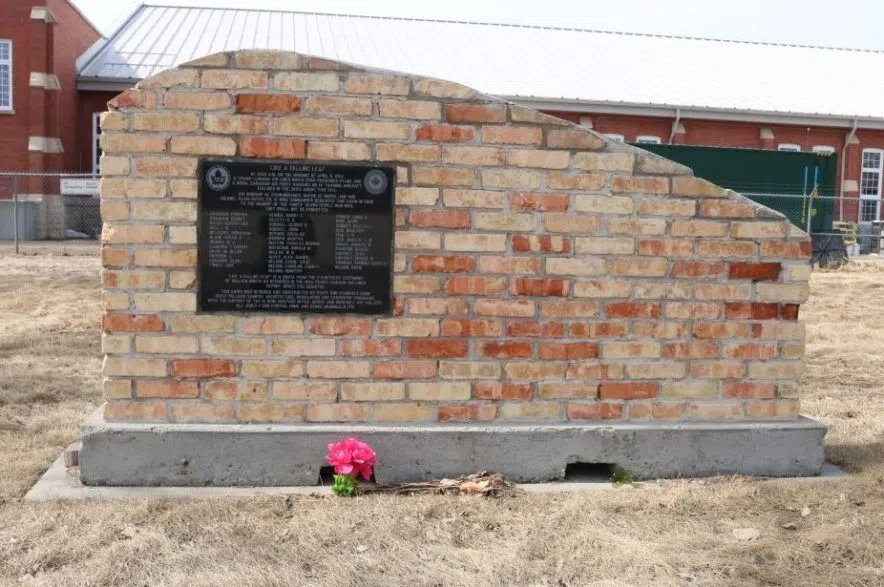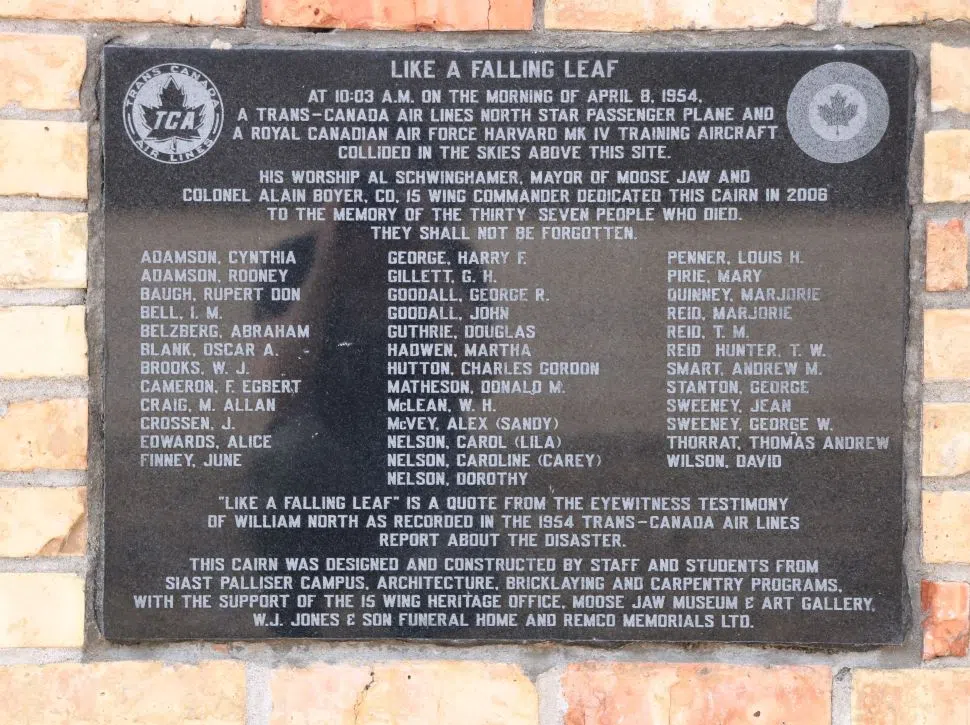By Tracey Moody
A mid-air crash between a Trans-Canada Air Lines passenger plane and a Harvard aircraft that happened at 10:03 a.m. on April 8, 1954, marked a significant moment in Moose Jaw’s history.
A total of 37 people died due to the crash, including the pilot of the Harvard, all 35 occupants of the passenger plane, and one woman, Martha Hadwen, who was cleaning the Hume residence on Third Avenue NE when it was hit by wreckage from the passenger plane.
Many people still remember the accident or remember family members telling them what happened in the aftermath of that day.
Moose Jaw Mayor Clive Tolley said he recalled the event that happened 70 years ago despite being a toddler at the time, playing outside with Donald Dickinson.
“We heard a very, very loud sound of part of the passenger airplane coming down, and we looked up and we saw this plane strike the Hume residence,” said Tolley.
He said he remembers his mother, Marian, telling him that victims were taken to the Moose Jaw Armoury to be identified and to notify families.
Gordon Shabbits said he was about three years old, too.
“I ran out of the house, and my mom told me, ‘Don’t leave the block,’ like any mother,” he said.
He remembers following a crowd of people up Main Street to where the Town N Country Mall is now, but used to be the Exhibition Grounds.
“I was trying to peek through a knot in the fence, and I couldn’t see anything, so a man put me on his shoulders to see over the fence,” Shabbits said.
He said he was told after that they were lining the deceased along the racetrack.
“I could see things; I didn’t know what they were,” he said.
Edna Dickinson was 23 at the time of the crash. Her sons were playing with Tolley at her house on the corner of Third Avenue NE and Oak Street.
She initially thought it was a car crash.
“There was no car going by, but I could hear something above my head,” she said. “I looked up, and I could see all this stuff flying down.
“Everybody that had small children was running to pull their kids in. I pulled my boys in.”
Dickinson said people converged on their neighbourhood shortly after the crash as people came to see what had happened.
“They followed where the traffic was going, and of course it led to my house,” she said.
“Cars were coming from all over – our yard was full of cars, and I think everybody’s driveways were full of cars and people chasing where they could see the plane coming down.”
She remembered curious strangers coming into her house.
“They were walking through my house – I didn’t know who they were,” she said. “The police or somebody was chasing the people and their cars off the street, so people would just come in your home so that the police didn’t chase them off.
“I only had a two-bedroom then, and it was full of people looking out the window, and my living room was full of people – just so they wouldn’t be chased off the area. We had no control over the crowd.”
Dickinson said it took time before people felt secure again after the incident.
“It took a long time to get over that crash sound,” she said. “If we heard a plane flying very low over the city, or over our area especially, it scared us – we ran outside.”
Tolley spoke about the incident’s aftermath for the City of Moose Jaw.
“I think it was a significant thing in Moose Jaw’s history,” he said. “(It’s) not something to celebrate, but something to learn from in terms of aircraft safety.
“It’s not a fond memory for me, but it is a memory, and it’s something each year when April 8 comes around, I think about it a little bit, and I think about the effect it may have had on our community.”
The Moose Jaw Museum and Art Gallery has had an exhibition about the 1954 plane crash since 2004, and there is also a memorial site behind the Moose Jaw Armoury.












